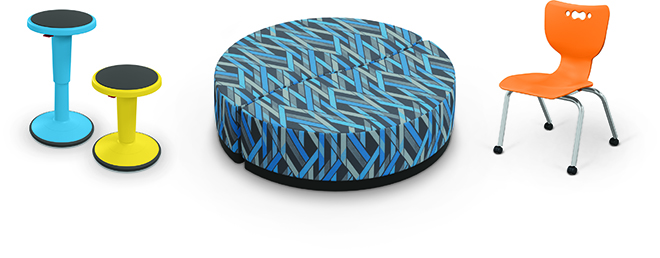HOW A 21ST CENTURY CLASSROOM DESIGN CAN PROMOTE THE 4 C'S OF LEARNING
Posted by MooreCo Inc on 23rd Dec 2019
Classroom design is a powerful tool in your arsenal for improving levels of student interaction and engagement. Active learning improves retention of knowledge by promoting the four C's of learning: Communication, Collaboration, Critical Thinking, and Creativity.
By providing an environment where students feel empowered to choose the micro-environment that fits their individual learning mode, we can put students in a position to succeed academically, socially, and emotionally.
 Snap Desk with Quad & Chevron Soft Seating Classroom Environment
Snap Desk with Quad & Chevron Soft Seating Classroom Environment
Adaptable Furnishings
Having the ability to quickly and easily change out furniture arrangements can be unexpectedly beneficial to a classroom environment. According to a case study conducted by Edutopia, flexible classrooms have lead to improved grades, happier and more engaged students, and higher participation with more in-depth conversations.
To get these or similar results, we recommend that you give students a choice in how they learn. Empowering students to take an active role in their own education instills a sense of pride and responsibility, as well as confidence in their own decision making skills.
Teachers in the study allowed children to sit wherever and however they wanted to in their classrooms (safety permitting), including lying on the floor, sitting on their knees at lower tables, or standing up. The kids seemed to have an instinctive understanding of why they worked better in a certain position and both their grades and their emotional well-being improved.
 Activity Table with Youth Height Leg Insert and Dot Soft Seating
Activity Table with Youth Height Leg Insert and Dot Soft Seating
Collaborative Learning Spaces
In the study, the classrooms were designed to promote a good community spirit by using multi-group pods or large tables to enable easy communication and teamwork. By adding casters or whiteboard tops, you create even more opportunities for students to create the space that works best for them, and allows them to work in creative ways, opening up new pathways in the brain.
 Shapes Desk in a variety of configurations with Hierarchy Seating
Shapes Desk in a variety of configurations with Hierarchy Seating
Flexible Seating
The classrooms were also designed with at least three kinds of seating options to allow students to choose the kind of seating that was most comfortable, or most conducive to their current activity or learning task. Seating could be traditional chairs, stools that allow micromovement and the bleeding off of excess energy, soft seating, height adjustable seating, and more.
 Hierarchy Grow Stool, Creator Soft Seating Half Rounds, Hierarchy Caster Chair
Hierarchy Grow Stool, Creator Soft Seating Half Rounds, Hierarchy Caster Chair
By providing students with control over their learning environment, encouraging them to play and experiment, to rearrange and reorganize, we are providing them with the tools that create more engagement with not only the instructor, but also their peers. By allowing them more comfort in their classroom spaces, we see improved grades, improved interactions, and overall happier kids.






